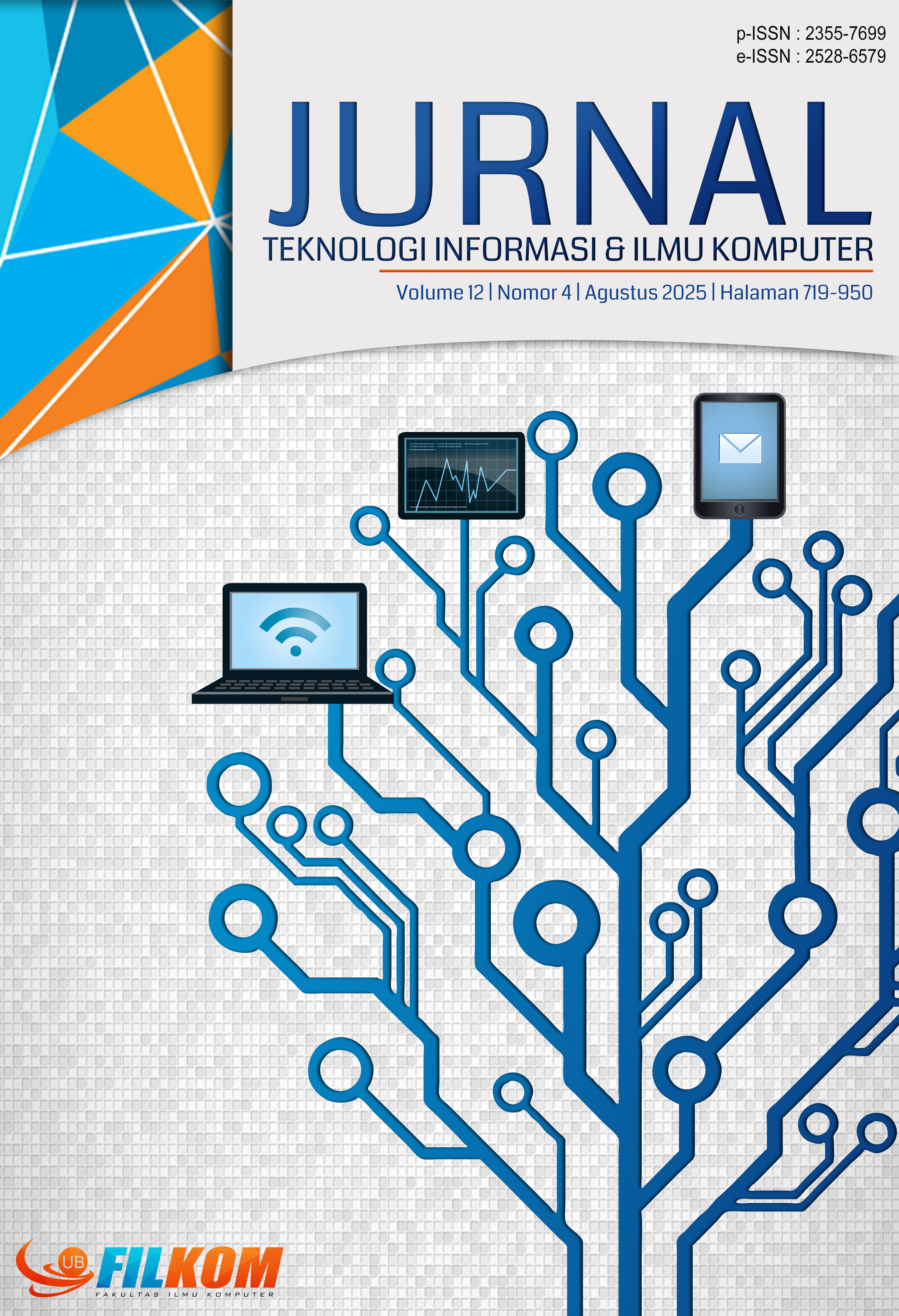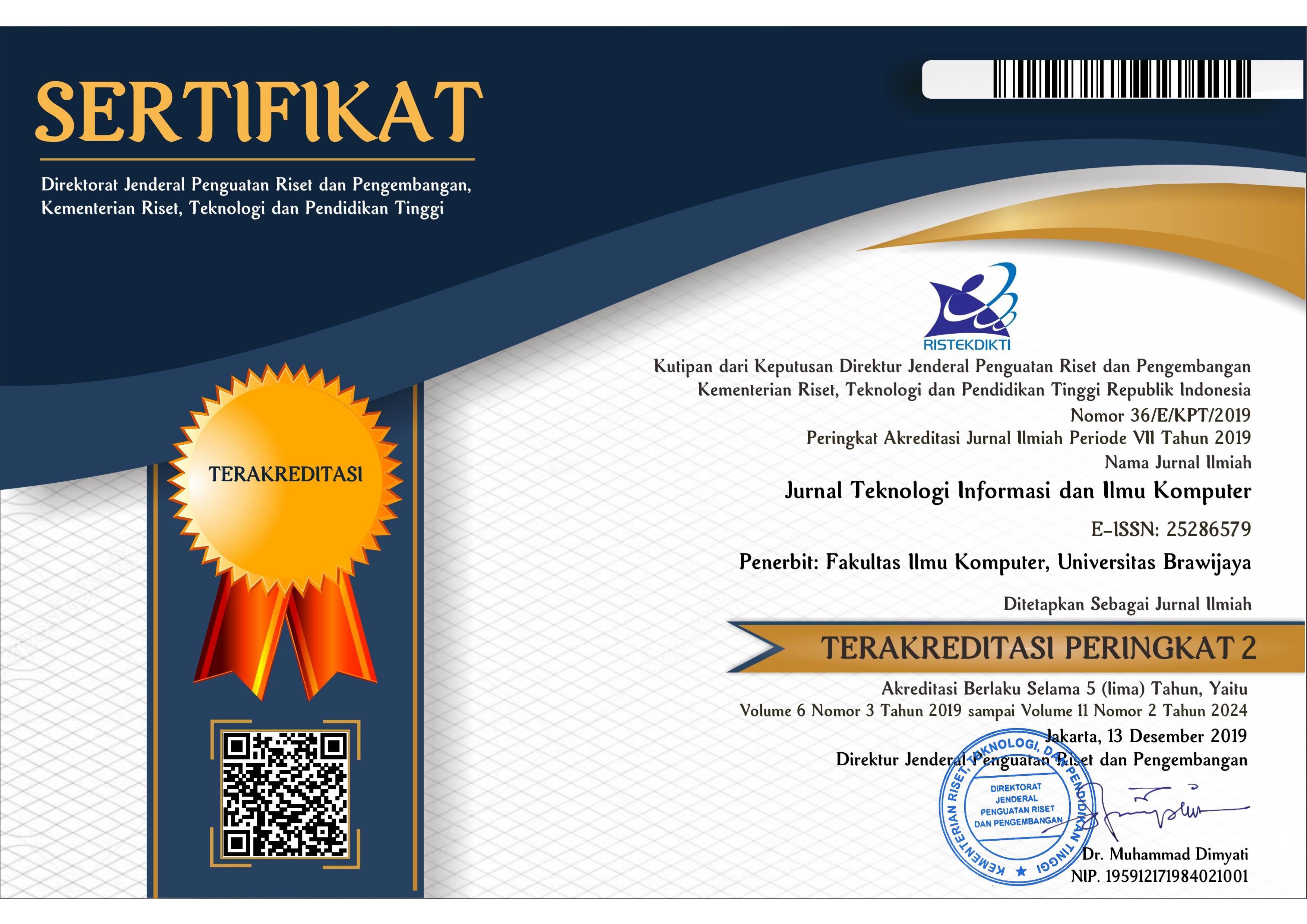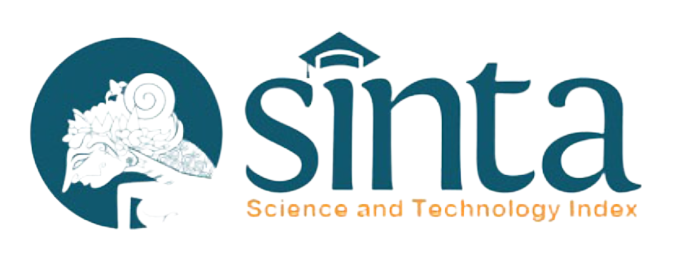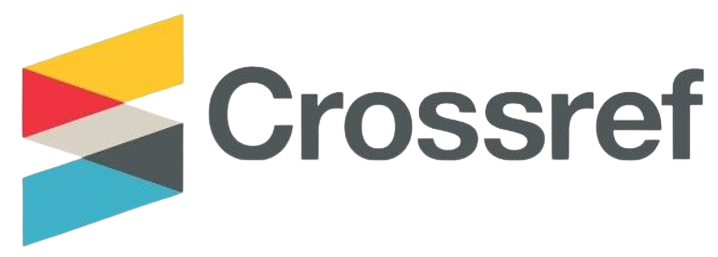Analisis Persepsi Mahasiswa Rumpun Ilmu Komputer Terhadap Pemanfaatan Artificial Intelligence Dalam Penulisan Tugas Akhir
DOI:
https://doi.org/10.25126/jtiik.124Kata Kunci:
artificial intelligence, penulisan akademik, perceived ease of use, perceived usefulnessAbstrak
Penelitian ini bertujuan untuk menganalisis persepsi dan penggunaan teknologi kecerdasan buatan (AI) dalam penulisan tugas akhir di kalangan mahasiswa Fakultas Ilmu Komputer, Universitas Brawijaya. Dengan menggunakan pendekatan kuantitatif, data dikumpulkan dari 102 mahasiswa tingkat akhir melalui kuesioner berbasis skala Likert. Analisis data dilakukan menggunakan Structural Equation Modeling (SEM) dengan pendekatan Partial Least Squares (PLS). Hasil penelitian menunjukkan bahwa persepsi kegunaan (perceived usefulness) memiliki pengaruh signifikan positif terhadap penggunaan aktual (actual usage) AI, sedangkan persepsi kemudahan penggunaan (perceived ease of use) tidak menunjukkan pengaruh yang signifikan. Mayoritas responden melaporkan bahwa AI membantu meningkatkan kualitas tugas akhir dan kreativitas mereka, serta dianggap mudah diakses dan fleksibel dalam penggunaannya. ChatGPT teridentifikasi sebagai aplikasi AI yang paling dominan digunakan. Penelitian ini juga mengidentifikasi beberapa hambatan dalam penggunaan AI, termasuk kebutuhan akan fitur yang lebih spesifik untuk mendukung penulisan akademik. Temuan ini memberikan wawasan penting bagi pengembang teknologi dan institusi pendidikan dalam mengoptimalkan penggunaan AI untuk mendukung proses penulisan akademik. Penelitian lanjutan direkomendasikan untuk mengeksplorasi aspek orisinalitas dan akurasi tulisan yang dibantu AI.
Abstract
This study aims to analyze the perception and usage of artificial intelligence (AI) technology in thesis writing among students of the Faculty of Computer Science, Universitas Brawijaya. Using a quantitative approach, data were collected from 102 final-year students through a Likert-scale-based questionnaire. Data analysis was conducted using Structural Equation Modeling (SEM) with the Partial Least Squares (PLS) approach. The results of the study indicate that perceived usefulness has a significant positive influence on the actual usage of AI, while perceived ease of use does not show a significant effect. The majority of respondents reported that AI helps improve the quality of their theses and their creativity, and it is considered easy to access and flexible in its usage. ChatGPT was identified as the most dominant AI application used. The study also identified several barriers to AI usage, including the need for more specific features to support academic writing. These findings provide important insights for technology developers and educational institutions in optimizing the use of AI to support academic writing processes. Further research is recommended to explore aspects of originality and accuracy in AI-assisted writing.
Downloads
Referensi
AGENCIA DE CALIDAD DE LA EDUCACIÓN [Education Quality Agency]. 2017. Informe de resultados de aprendizaje escritura 2016 sexto básico [2016 learning outcomes report writing sixth grade]. Ministerio de Educación [Ministry of Education]. Tersedia di <http://archivos.agenciaeducacion.cl/resultados_nacionales_escritura_2016.pdf>
AUSTRALIAN CURRICULUM AND ASSESSMENT REPORTING AUTHORITY [ACARA]. 2021. National assessment program: Literacy and numeracy. Australian Curriculum and Assessment Reporting Authority. Tersedia di <https://reports.acara.edu.au/NAP>
BAÑALES, G., AHUMADA, S., GRAHAM, S., PUENTE, A., GUAJARDO, M., & MUÑOZ, I. 2020. Teaching writing in grades 4-6 in urban schools in Chile: A national survey. Reading and Writing, 33, pp. 2661-2696. https://doi.org/10.1007/s11145-020-10055-z
CAMACHO, A., & ALVES, R. A. 2017. Fostering parental involvement in writing: Development and testing of the program cultivating writing. Reading and Writing, 30(2), 253-277. https://doi.org/10.1007/s11145-016-9672-6
CHEN, L., & AKLIKOKOU, A. K. 2020. Determinants of E-government adoption: testing the mediating effects of perceived usefulness and perceived ease of use. International Journal of Public Administration, 43(10), pp. 850-865.
CHIN, W. W. 1998. The partial least squares approach to structural equation modeling. Modern methods for business research, 295(2), pp. 295-336.
CRESWELL, J. W. 2009. Research design: Qualitative, quantitative, and mixed methods approaches. SAGE.
DAVIS, F. D. 1986. A technology acceptance model for empirically testing new end-user information systems: Theory and results. Doctoral dissertation, Cambridge, MA: Massachusetts Institute of Technology.
DAVIS, F. D. 1989. Perceived usefulness, perceived ease of use, and user acceptance of information technology. MIS Quarterly, 13(3), pp. 319-340. https://doi.org/10.2307/249008
DAVIS, F. D., BAGOZZI, R. P., & WARSHAW, P. R. 1989. User acceptance of computer technology: A comparison of two theoretical models. Management Science, 35(8), pp. 982-1003. https://doi.org/10.1287/mnsc.35.8.982
DWIVEDI, Y. K., RANA, N. P., JANSSEN, M., LAL, B., WILLIAMS, M. D., & CLEMENT, M. 2017. An empirical validation of a unified model of electronic government adoption (UMEGA). Government Information Quarterly, 34, pp. 211–230. https://doi.org/10.1016/j.giq.2017.03.001
ELMUNSYAH, H., SUSWANTO, H., ASFANI, K., & HIDAYAT, W. 2018. The effectiveness of plagiarism checker implementation in scientific writing for vocational high school. In Proceedings of the International Conference on Indonesian Technical Vocational Education and Association (pp. 192-196). Atlantis Press. https://doi.org/10.2991/aptekindo-18.2018.42
FITRIA, T. 2021. Grammarly as AI-powered English writing assistant: Students’ alternative for writing English. Metathesis: Journal of English Language, Literature, and Teaching, 5(1), pp. 65-78. https://doi.org/10.31002/metathesis.v5i1.3519
GAYED, J. M., CARLON, M. K. J., ORIOLA, A. M., & CROSS, J. S. 2022. Exploring an AI-based writing assistant’s impact on English language learners. Computers and Education: Artificial Intelligence, 3, 100055. https://doi.org/10.1016/j.caeai.2022.100055
GRAHAM, S. 2019. Changing how writing is taught. Review of Research in Education, 43(1), pp. 277-303. https://doi.org/10.3102/0091732X18821125
HAIR, J. F., RISHER, J. J., SARSTEDT, M., & RINGLE, C. M. 2019. When to use and how to report the results of PLS-SEM. European business review, 31(1), pp. 2-24.
INAYAH, R., & NANDA, H. 2016. Students’ problems in writing argumentative essay: A case study in a senior high school in Padang. Journal of English Language Teaching, 5(1), pp. 1-15.
JAHANGIR, N., & BEGUM, N. 2008. The role of perceived usefulness, perceived ease of use, security and privacy, and customer attitude to engender customer adaptation in the context of electronic banking. African Journal of Business Management, 2(1), pp. 032–040.
JONES, A. B., & KAUPPI, K. 2018. Examining the antecedents of the technology acceptance model within e-procurement. International Journal of Operations and Production Management, 38(1), pp. 22-42. https://doi.org/10.1108/IJOPM-06-2015-0346
KANGASHARJU, H., LINDHOLM, S., & NOKELAINEN, P. 2022. Artificial intelligence in Finnish high school education: A student perspective. Computers and Education: Artificial Intelligence, 3, 100058. https://doi.org/10.1016/j.caeai.2022.100058
KHATRI, M. 2021. How digital marketing along with artificial intelligence is transforming consumer behaviour. International Journal for Research in Applied Science and Engineering Technology, 9(VII), pp. 523-527.
KOLTOVSKAIA, J. 2020. Understanding the role of artificial intelligence in English language teaching: A case study of Chinese students. Journal of Educational Technology Development and Exchange, 13(2), pp. 55-74. https://doi.org/10.18785/jetde.1302.05
KUMAR, M. S., & KRISHNAN, D. S. G. 2020. Perceived usefulness (Pu), perceived ease of use (peou), and behavioural intension to use (biu): Mediating effect of attitude toward use (AU) with reference to mobile wallet acceptance and adoption in rural India.
LABONTÉ, R., & SMITH, R. 2022. Students' perceptions as practical tools in educational evaluation. Journal of Educational Evaluation, 45(3), pp. 112-130.
MILLER, J., & WU, R. 2021. AI and the future of learning: The transformative impact on student engagement and education. Educational Technology Journal, 58(4), pp. 112-125.
MYERS, J., MILLIGAN, K., & MORGAN, K. 2016. Enhancing motivation and engagement through collaborative writing: A case study of senior secondary students. Journal of Adolescent & Adult Literacy, 60(2), pp. 163-171. https://doi.org/10.1002/jaal.577
NAZARI, A., BABAI, E., & GHOLAMI, J. 2021. The role of artificial intelligence in language learning: A case of chatbots. Journal of Language and Translation, 11(2), pp. 23-34.
PETER, O., & SINGARAVELU, G. 2020. Developing writing skills through artificial intelligence. International Journal of Advanced Science and Technology, 29(8), pp. 411-421.
PITRIANTI, F., & GASANTI, P. 2020. Tantangan dalam menulis karya ilmiah bagi mahasiswa. Jurnal Ilmu Pendidikan, 6(1), pp. 45-58.
POALELUNGI, DG, MUSAT, CL, FULGA, A., NEAGU, M., NEAGU, AI, PIRAIANU, AI, & FULGA, I. 2023. Memajukan Perawatan Pasien: Bagaimana Kecerdasan Buatan Mengubah Layanan Kesehatan. Jurnal pengobatan pribadi, 13(8), pp. 1214.
PRASTIAWAN, D. I., AISJAH, S., & ROFIATY, R. 2021. The effect of perceived usefulness, perceived ease of use, and social influence on the use of mobile banking through the mediation of attitude toward use. APMBA (Asia Pacific Management and Business Application), 9(3), pp. 243-260.
RAZACK, S., NAYAK, R., & SHARMA, P. 2021. Leveraging AI tools for enhancing writing skills in secondary education. Journal of Educational Computing Research, 59(3), pp. 657-672. https://doi.org/10.1177/0735633120987325
SCHERER, R., SIDDIQ, F., & TONDEUR, J. 2016. The technology acceptance model (TAM): A meta-analytic structural equation modeling approach to explaining teachers’ adoption of digital technology in education. Computers & Education, 95, pp. 17-34. https://doi.org/10.1016/j.compedu.2015.12.012
STAMOVA, I., & DRAGANOV, M. 2020. Artificial intelligence in the digital age. In IOP Conference Series: Materials Science and Engineering, 940(1), p. 012067.
SUMAKUL, J., LIN, C., & WANG, J. 2022a. Using AI to assist English writing: A study on EFL learners. International Journal of Emerging Technologies in Learning, 17(4), pp. 85-97. https://doi.org/10.3991/ijet.v17i04.23425
SUMAKUL, J., LIN, C., & WANG, J. 2022b. Exploring the use of artificial intelligence in teaching English writing. International Journal of Learning, Teaching and Educational Research, 21(1), pp. 14-26. https://doi.org/10.26803/ijlter.21.1.2
SUREDA-NEGRE, J., COMAS-FORGAS, R., & OLIVER-TROBAT, M. F. 2015. Academic plagiarism among secondary and high school students: Differences in gender and procrastination. Comunicar: Media Education Research Journal, 23(45), pp. 103-111. https://doi.org/10.3916/C45-2015-11
TAHAR, A., RIYADH, H. A., SOFYANI, H., & PURNOMO, W. E. 2020. Perceived ease of use, perceived usefulness, perceived security and intention to use e-filing: The role of technology readiness. The Journal of Asian Finance, Economics and Business, 7(9), pp. 537-547.
TEO, T. 2019. Students and technology: Exploring the acceptance and use of technology by teachers in education. Journal of Educational Technology, 52(1), pp. 25-38.
UNESCO IITE. 2020. Artificial intelligence in education: Challenges and opportunities.
UNESCO Institute for Information Technologies in Education. Tersedia di <https://iite.unesco.org/publications/ai-in-education>
UNESCO. 2017. Writing for life: Improving literacy and writing skills for lifelong learning.
UNESCO Institute for Lifelong Learning. Tersedia di <https://uil.unesco.org/literacy/writing-life>
VENKATESH, V., MORRIS, M. G., DAVIS, G. B., & DAVIS, F. D. 2003. User acceptance of information technology: Toward a unified view. MIS Quarterly, 27(3), pp. 425–478. https://doi.org/10.2307/30036540
WIDYANA, G., SUPARMAN, A., & RAHARJA, S. 2022. Integrating AI applications in academic writing: A case study from Indonesian universities. Journal of Education and Practice, 13(4), pp. 134-145. https://doi.org/10.7176/JEP/13-4-15
Unduhan
Diterbitkan
Terbitan
Bagian
Lisensi
Hak Cipta (c) 2025 Jurnal Teknologi Informasi dan Ilmu Komputer

Artikel ini berlisensiCreative Commons Attribution-ShareAlike 4.0 International License.

Artikel ini berlisensi Creative Common Attribution-ShareAlike 4.0 International (CC BY-SA 4.0)
Penulis yang menerbitkan di jurnal ini menyetujui ketentuan berikut:
- Penulis menyimpan hak cipta dan memberikan jurnal hak penerbitan pertama naskah secara simultan dengan lisensi di bawah Creative Common Attribution-ShareAlike 4.0 International (CC BY-SA 4.0) yang mengizinkan orang lain untuk berbagi pekerjaan dengan sebuah pernyataan kepenulisan pekerjaan dan penerbitan awal di jurnal ini.
- Penulis bisa memasukkan ke dalam penyusunan kontraktual tambahan terpisah untuk distribusi non ekslusif versi kaya terbitan jurnal (contoh: mempostingnya ke repositori institusional atau menerbitkannya dalam sebuah buku), dengan pengakuan penerbitan awalnya di jurnal ini.
- Penulis diizinkan dan didorong untuk mem-posting karya mereka online (contoh: di repositori institusional atau di website mereka) sebelum dan selama proses penyerahan, karena dapat mengarahkan ke pertukaran produktif, seperti halnya sitiran yang lebih awal dan lebih hebat dari karya yang diterbitkan. (Lihat Efek Akses Terbuka).















